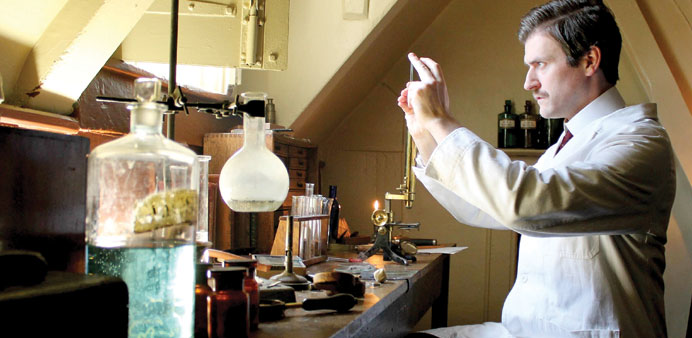By Luaine Lee
Before there was a Quincy M.E, a CSI, or a Bones, there was a fictional character, who set the standard for all those forensic heroes to follow: Sherlock Holmes.
With his eccentric mumblings, omnipresent magnifying glass and deerstalker hat, it was Holmes who actually led the way to modern crime investigation.
How he did that will be the subject of PBS’ two-hour special, How Sherlock Holmes Changed the World, airing December 17.
Before Sir Arthur Conan Doyle’s intrepid creation, crime solving was mostly interrogation. There was no such thing as protecting the crime scene, gathering discrete evidence, examining blood spatter or dusting for fingerprints.
When he began working for the police in Taiwan in the 1960s they still utilised interrogation as the major method of solving crimes, says Dr Henry Lee, one of the forensic experts on the show.
“At that time when we solved cases, basically (we relied) on interrogation. Just run up all the suspects until one confesses. If nobody confesses, we usually take them to the back room. Five minutes later, we got someone confessing.”
Lee is known for his work in forensic serology — the identification of blood, hair, semen and tissue types. He’s also an expert in fingerprint matching, ballistics, fiber and paint sample investigation and blood splatter reconstructions.
The process is slow and meticulous, as he painstakingly reconstructs the crime, pores over the evidence and cautiously ventures hypotheses about how things might have happened, just the way Holmes did.
When Conan Doyle created his literary lion in 1887 it was just before the Jack the Ripper murders occurred in Victorian London. Six murders were committed in less than 90 days, and the police were stymied. The crime scenes had been contaminated and evidence collection was not part of police procedure. The crimes were never solved.
Conan Doyle’s first Sherlock adventure, A Study in Scarlet, featured Holmes applying methods that would be used 120 years later: he protected the crime scene, searched for trace evidence, smelled the surroundings, measured everything and devised deductions.
British actor Benedict Cumberbatch is essaying the character of Holmes on PBS’ Masterpiece series, which returns for a new season on January 19.
He finds the role both inspiring and exhausting. “It is a rare challenge, for an audience and for an actor, to take part in something with this level of intelligence and wit,” he says. “And you have to play with it. You have to really enjoy it.
“It takes a lot of effort to play clever. It takes very little effort to look clever, as I found out through my character for some reason. And it’s the sort of challenge that you just have to love, and I really do. I absolutely love every minute of it as hard as it can be.”
Fiction aside, “How Sherlock Holmes Changed the World” examines real crimes like the Sam Sheppard and the Michael Curley case and how they were solved utilising Holmes’ techniques.
But despite our modern-day expertise and the prominence of DNA profiling, we still sometimes miss the mark, says Lee. “We still mess up at the crime scene. All the recent cases from the Kennedy assassination to the Jon-Benet Ramsey to O J Simpson — bottom line is the crime scene. If the crime scene is handled correctly, properly, we can recognise, collect those physical evidence. Then (in the) laboratory we can do our job to examine the evidence. Then the case should be resolved,” he says.
When Lee became the chief state criminologist in Connecticut in the ’70s, he applied many of Holmes’ techniques, primarily deductive reasoning and logic, he says.
Lee — who is a PhD, not an M D — says that much of what passes for scientific investigation today on TV is more fantasy than fact.
“For example, the forensic light source, the laser. We use it in our work ... but you can’t just shine a laser and everything pops up,” he says. A police sergeant once called Lee complaining that his chief was upset with him when the new laser he’d procured wasn’t producing results.
“He took it to the crime scene three times and did not find any evidence ... He said, ‘Why on the television show, every night it finds the evidence?’ And so I have to spend about 15 minutes explaining to the chief: ‘You need goggles. You need wavelengths. You have to know what to select, what chemical to spray. Light sources will not automatically produce evidence.’”
It was a French fan of Holmes, scientist Edmond Locard, who built the first real forensic lab in 1910. Locard reserved mineral, hair, fiber and soil samples and studied everything under the microscope. He devised what is known as the “exchange principle,” which states that when two things come into contact with each other they each leave a trace on the other.
Kimberlee Sue Moran, a forensic scientist appearing on the show, observes, “That is something right out of a Sherlock Holmes novel, that whenever two things come into contact, they leave a trace. And as forensic scientists we play that out on every crime scene that we come across,” she says. — McClatchy-Tribune News Service/MCT
THE LAB: The first forensic lab was established by French scientist Edmond Locard in 1910. His work is depicted in PBS’ How Sherlock Holmes Changed the World, premiering on December 17.

